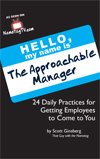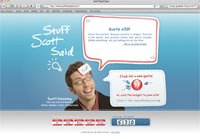 Scott: Thanks for sitting down with me today, Scott.
Scott: Thanks for sitting down with me today, Scott.
Scott: No problem.
Scott: OK, so, first of all, do you just write out and stick on a new nametag every day?
Scott: Every few months I sit down and write out about a hundred in advance, then just take one whenever I need it.
Scott: Do you reuse your nametags?
Scott: Unless I accidentally splash soy sauce on it, I’ll remove the nametag from one shirt and stick it on another. And I reuse whenever possible so I’m not wasting too much paper.
Scott: Really? Have you been the target of environmentalists who claimed you were killing the rain forests by wearing too many nametags?
Scott: Not yet, but it’s only a matter of time.
Scott: Do you hand write each nametag?
Scott: Absolutely. Hecho de mano con amor.
Scott: Oh, um, I don’t speak French.
Scott: Sorry. That means, “Made by hand with love.”
Scott: Got it. And I noticed that every nametag is white with a red border and blue writing. Any reason behind that?
Scott: Actually, that’s the one technical element of nametagging that I have absolutely no explanation, philosophy or blog post to support. I just think it looks nice.
Scott: So, it’s not a patriotic thing?
Scott: Not really. I think the fact that I made an entire career out of wearing a nametag is more patriotic that the colors of said nametag. God bless America.
Scott: Have you ever thought about just getting a few permanent, higher quality nametags?
Scott: Yes. And there IS a philosophy behind why I choose NOT to go that route. I don’t feel like explaining it, so you can read it here.
Scott: OK, so, what are the most common reactions to your nametag?
Scott: In my first book, I broke it down into five categories:
o 35% of the people ask a question, i.e., “What’s with the nametag?”
o 30% of the people say hello, i.e., “Hey Scott!”
o 20% of the people crack a joke, i.e., “So, is that so you don’t forget who you are?”
o 10% of the people think I’m an employee, “Excuse me, Scott, but do these panties come in crotchless?”
o 5% of the people lash out, i.e., “Hey dumbass, you’re still wearing your nametag!”
Scott: And then, when people ask you about your nametag, what do you say?
Scott: Four simple words: “I always wear it.”
Scott: How do people usually respond to that answer?
Scott: There are only two possible responses. Two personality types, really: The Lovers and The Haters. 10% of the people (The Haters) will say, “That’s the stupidest idea I’ve ever heard in my life.” And then 90% of the people (The Lovers) will say, “That’s the coolest idea I’ve ever heard in my life.”
Scott: Do you ever get halfway down the street and realize you’ve forgotten to put on your nametag?
Scott: About once a month. Come on – I’m human.
Scott: What happens if you lose your nametag, someone peels it off or it gets ripped or dirty?
Scott: I carry about ten pre-written spares in my wallet at all times, plus another ten blank nametags just in case somebody asks for one.
Scott: Do people really ask for them?
Scott: All the time. And you know, it’s funny. I imagine that when I’m a Grampa, nametags will become my version of butterscotch candy. “Hey Grampa Scott! Can we have nametags? Huh? Can we? Can we?” I mean, I know that’s a long way away since I’m only 29 right now, but I am looking forward to the Old Me. I think it’ll work out well since everyone hates butterscotch.
Scott: So, does that mean your wallet is super thick?
Scott: Yeah. Like, Constanza thick. I have back problems.
Scott: OK, so, when people ask for nametags – and then you pull one out of your wallet – do people ever follow through and put it on?
Scott: Actually, that’s the funny part. Only about 50% the people put on the nametag they asked for. Probably because they didn’t expect me have one in my wallet. It’s pretty funny. I like calling people’s bluffs.
Scott: So, you’re a gambling man?
Scott: No. Gambling is a waste of money and an exercise in stupidity. Deniro said it best in Casino: “The more they play, the more they lose. In the end, we get it all.”
Scott: How many nametags have you used in total?
Scott: That’s an impossible number to calculate because I reuse so many of them. Still, if I had to guess, after 3,000+ days, I’ve probably written out about 10,000 “Scott” nametags. That’s for me, personally. But if you factor in all the nametags I’ve used for non-Scott reasons (audience exercises, mailing labels, vandalism) I’d probably tack on another 10,000 or so.
Scott: Is there a specific brand of nametags you use?
Scott: On my 21st birthday (one year into the nametag journey) my friend Kristen bought me a pack of MACO NB-264 Red Border Adhesive Badges. They’ve been my standard every since. They stick to everything. They never peel off. They feel smooth like fax paper and rarely fade. They’re the best on the market, and believe me, I’ve tried them all.
Scott: How much money a month do you spend on nametags?
Scott: $0.00
Scott: So then, does the nametag company sponsor you?
Scott: Funny story. When I was in college I used to write regular letters to MACO, alerting them about my upcoming book. (You know, Andy Dufregne style.) Sadly, I never heard back from them. So, when I did my first ever interview – on CNN Headline News, January 13th, 2003 – I mentioned MACO’s name and gave them a fantastic endorsement – then sent a copy of that interview to their marketing department. Two weeks later, 10,000 nametags were delivered to my front door. Ever since then, I’ve never run out.
Scott: Do you think everyone should wear nametags?
Scott: All the time, no. More often, yes. I actually wrote a detailed prediction about what the world would look like if everybody was required to wear nametags in the future. You can read it here.
Scott: What would have happened if the woman you fell in love with didn’t like you (or didn’t LET you) wear a nametag?
Scott: Then I would break up with her.
Scott: For shizzle?
Scott: My nizzle. Yep. Rejecting the nametag = Rejecting me as a person. Think about it: Would YOU want to marry someone who didn’t accept you? No way! Now, I will say that if she didn’t like the nametag, I’d still be cool with that. No hard feelings. And I’d respect her opinion of me. But we clearly wouldn’t be able to get married.
Scott: Wow. I hope that doesn’t narrow the partner pool down too much…
Scott: It won’t. That’s one of the coolest (and most unexpected) things about wearing a nametag 24-7. It’s a filter. A walking Rorschach Test. An immediate indicator of someone’s reaction to my Truth. So, after nine, years and tens of thousands of encounters, I’ve discovered that how someone reacts to my nametag tells me almost everything I need to know about that person. Namely, whether or not we will get along, much less get hitched.
Scott: So, does that mean you will you wear a nametag during your wedding?
Scott: Damn right.
Scott: Will you make your bride-to-be to wear a nametag during your wedding?
Scott: Well, I’m off the market now. And my future wife drives a pink car. She doesn’t need a nametag.
Scott: Will you require your kids to wear nametags?
Scott: Not unless they want to get made fun of, beat up, stared at and emotionally/physically/ psychological tortured every day of their lives.
Scott: What would cause you stop wearing a nametag?
Scott: If gangsters kidnapped my family and the ransom was “never wearing a nametag again,” I guess I would probably take it off. Fortunately, I have a tattoo, and nobody can take THAT off.
Actually, wait, I take that back. I’m sure the gangsters would torture me in some way that would involve removing my tattoo with a belt sander. Damn it. Well, in that case, I guess I’d be done wearing nametags if that happened. And you know, I guess I’d be cool with that. Fortunately, my nametag merely identifies me – it doesn’t DEFINE me. “You can steal my nametag but you’ll never steal my truth,” I like to say. Crap. I hope my answer to this question didn’t just give some terrorist any ideas…
Scott: Wait, isn’t that a line from “Pride” by U2?
Scott: Close. Their lyric is, “They took your life; they’ll never take your pride.”
Scott: Right. Man that’s a great song.
Scott: I know. You should hear their new album. It kicks ass.
Scott: Good call. I’ll check it out on ITunes.
Scott: Actually, I already downloaded it for us.
Scott: Thanks.
Scott: Word.
Scott: OK, so, what happens on those days where you don’t feel like being friendly? Do you still wear your nametag?
Scott: Yeah, I just don’t leave the house. As Mr. Miyagi once said, “The best way to block a punch is to not be there.”
Scott: How did you friends and family first react when you started wearing your nametag nine years ago?
Scott: My friends hated it. My teachers loved it. My parents thought it was cool. My Grampa thought – that I thought – he was getting Alzheimer’s. That was pretty funny. But eventually, most people got used to it. Especially my friends who slowly realized that my nametag could help them pick up chicks.
Scott: Really? How?
Scott: Well, in college, girls would just come up and start talking to me. Really cute ones, too. It was weird, yet awesome. And usually what would happen is, after about five minutes of realizing that I was a total dork and basically out of my goddamn mind, right before the girl would lose interest, I’d go grab one of my more handsome friends and say, “Here, you talk to Wade. I’m going to go get a refill on my ice water. Nice talkin to ya!”
Scott: So, wearing a nametag didn’t actually help YOU get any dates?
Scott: One time in my life I ended up dating a girl for about four months as a direct result of a nametag-related interaction. Of course, she ended up being an alcoholic nymphomaniac, so, obviously, THAT ended awkwardly. Other than that, that’s about all the luck I had. When it came to dating, I learned that I just wasn’t closer. It’s not in my blood. I’m more of an opener. My brother’s the closer in the family.
Scott: Do you ever change the name on your nametag?
Scott: Once a year on Halloween. It’s my favorite day of the year because for once, I don’t have to be myself. So, whatever my costume is, I write my nametag to reflect that. For example, in 2008 I went as Texas Oil Tycoon Dalton Vaughn, Jr.
Scott: OK, one final question and then I’ll let you go.
Scott: Thank God. MAN you ask a lot of questions.
Scott: I know. That’s kind of my thing.
Scott: It’s cool. I’m the same way.
Scott: So, it’s been nine years now. 3,000+ days. You’ve just finished your eighth book. You’ve won awards, been featured in endless media outlets and continue to grow your business in diverse, creative and exciting ways. Ultimately, you have made a difference in the lives of (potentially) millions of people. What do you think about all this?
Scott: I think there is no logical reason why any of this should be happening to me. Seriously. It makes zero sense. Still, it IS happening to me, and it’s BEEN happening to me in a successful and consistent way for a long time now. So I must be doing something right. As such, the only conclusion I can come up with is: Logic is overrated. Irrationality? That’s the secret. Or, maybe another way to put it is, “Don’t accept other people’s rationality.” Yeah. I like that. Because in my experience, the more rules you are to exception to, the more successful you will become.
Scott: Wow. That bears repeating: “The more rules you are to exception to, the more successful you will become.”
Scott: I know. That was a good one. I should go Tweet that.
Scott: Actually, I just did.
Scott: Jerk.
Scott: Takes one to know one.
Scott: I know you are but what am I?
Scott: Wait, you?
Scott: No, putz. Me.
Scott: Huh?
Scott: I accept your apology.
Scott: What?
Scott: You’re welcome.
Scott: OK. My head hurts.
Scott: So does mine.
Scott: This interview is over.
Scott: You started it.
LET ME ASK YA THIS…
How long did it take you to realize this blog post was my April Fool’s joke?
LET ME SUGGEST THIS…
For the list called, “101 Life Lessons Learned from Wearing a Nametag 24-7,” send an email to me, and I’ll send you the list for free!
* * * *
Scott Ginsberg
That Guy with the Nametag
Author, Speaker, Coach, Entrepreneur
[email protected]
 Never the same speech twice.
Never the same speech twice.
Always about approachability.
Watch The Nametag Guy in action here!
 The secret to growing bigger ears is listening for the intangible forces behind people’s physical expressions.
The secret to growing bigger ears is listening for the intangible forces behind people’s physical expressions.  If they can’t come UP to you; how will they ever get BEHIND you?
If they can’t come UP to you; how will they ever get BEHIND you?
 Scott: Thanks for sitting down with me today, Scott.
Scott: Thanks for sitting down with me today, Scott.
 The world’s FIRST two-in-one, flip-flop book!
The world’s FIRST two-in-one, flip-flop book! In this multi-post series, we’re going to explore daily practices to help you become known as the most approachable person in your organization.
In this multi-post series, we’re going to explore daily practices to help you become known as the most approachable person in your organization. Who’s quoting YOU?
Who’s quoting YOU? When you label, you judge.
When you label, you judge. If you want to grow bigger ears, remember these four words:
If you want to grow bigger ears, remember these four words:  Many of my clients, colleagues, readers and audience members come to me with the same challenge:
Many of my clients, colleagues, readers and audience members come to me with the same challenge:
 The only judgment people can (honestly) make is how interacting with you made them FEEL.
The only judgment people can (honestly) make is how interacting with you made them FEEL.  “Nobody around here ever listens to me!”
“Nobody around here ever listens to me!” Who’s quoting YOU?
Who’s quoting YOU? Four words that changed my life forever:
Four words that changed my life forever: